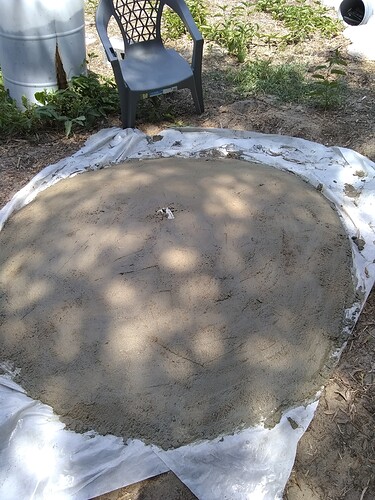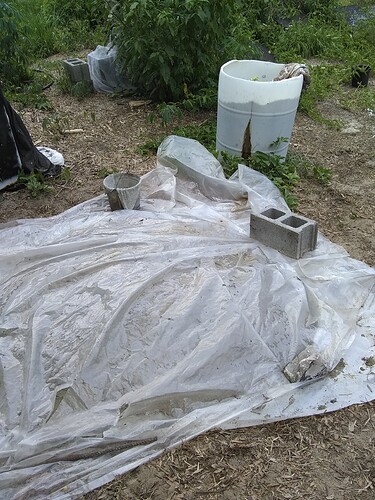Rindert,
These are all “cool” projects! As for the pot, I would just paint it with BBQ black or flat black enamel. You could certainly use any dark color cloth to see what works best!! Hopefully, it wouldn’t get hot enough to burn, but the insulating qualities of the cloth might work against you. ![]()
So, I am now trying out making paper crete. never done this before… I decided to run the cardboard thru a garbage disposal. I made a mess the first time around, but now I think I have the hang of this.
First wet the cardboard, then tear into small chunks, run thru the garbage disposal, then dump out on a bed sheet to capture the small cardboard fibers.
I now have the sand, cement, and now will process the cardboard and see what happens.
I would probably put it in a box with a small air vent. If you want to stick with fabric look for a piece of landscape fabric from a landscaper. black plastic would work as well.
I wouldn’t want to paint my pot. ![]()
I think the hardest part is going to be getting it reduced fast enough to keep the yeast naturally in the apples from working.
I’m more worried about over heating. The syrup tastes like molasses if you over heat it.
There is a small vent hole in the lid. I’m going to try keeping that vent hole exposed while covering the rest with dark material. And I’ll see if can control it somehow by making the reflector more of less efficient. I have a notion that my muscle wire spring might help. I’ll do some trials beforehand using just water in the pot. I think if I can evaporate 3 gallons in 4 hours, in the middle of the day it I’ll then do the final stage on the cooking range.
Rindert
I don’t think it is going to get quite that hot unless you have a reflector or larger collector With a quick google, the hottest temperature was 180F for a solar thermal water collector. You will lose some water.
For maple syrup, I have a pot similar to that but I think it is 12q and I heat it up to boiling temp with the lid on then move the lid off it part of the way, usually the pot handle is designed to hold the lid so the condensation doesn’t drip back in the pot. But it still takes longer then 4 hours.
The induction heater is about 2x as fast as the resistance heater for the same wattage for my use case.
Boiling is a surface area contact game, and pots aren’t really that great.
A faster way would be to heat air then pump the hot air through the pot. The bubbles greatly increase the surface area, and the water vapor gets trapped in the bubbles. You could run a stainless steel coil in it the pot. Some Maple syrup makers use steam to heat the syrup. Most fluted ‘sap’ pans that increase the surface area.
The more I think about it, your best bet, might be to create a solar hot air collectors like the ones out of old pallets, then push air so it heats the pot kind of like a warmer at a buffet. Not because it will boil faster, but you will need a collector of some sort, and they are more versatile, like you can use them to heat the garage during the winter. IF you had a pool then I would suggest like a solar hot water system.
If you use a collector like a trough or parabolic, or
If you want to get electronic, then you could use an arduino and control the temperature. then move the collector, but I would think about indirect heating, like heat bricks, or water or something that you can control better, but that increases the work and complicates the system, which I don’t think you are looking to do.
It seems to me (in my admitted ignorance ![]() ) that trying to get all that water through a little hole might slow the process. Could you use a sloped sheet, dark colored, facing the sun to collect the heat, and slowly run a film of sap down the surface? Maybe use a low-flow pump to cycle the sap? Lots of surface area per volume of sap, lots of ventilation to keep the humidity low and evaporation rate high, relatively. There might be issues with viscosity as the sap thickens, but then you could move to the range. The energy cost might be pretty low for the first part of the process. You might be able to speed it up a bit with additional reflectors, or a concentrator mirror.
) that trying to get all that water through a little hole might slow the process. Could you use a sloped sheet, dark colored, facing the sun to collect the heat, and slowly run a film of sap down the surface? Maybe use a low-flow pump to cycle the sap? Lots of surface area per volume of sap, lots of ventilation to keep the humidity low and evaporation rate high, relatively. There might be issues with viscosity as the sap thickens, but then you could move to the range. The energy cost might be pretty low for the first part of the process. You might be able to speed it up a bit with additional reflectors, or a concentrator mirror.
I 'm also thinking about a Fresnel lens because I could then use it to burn weeds also.
Rindert
I had the screen from an old projection TV at one time but never figured out what to do with it and don’t remember what happened to it. Now I know what it could have been good for.
Someone has a video where they are melting glass with one.
Kent,
I believe, IMHO, that temperature control would need constant monitoring or you would cook the sap overly much. I have a passive solar air to air panel (a perpetual experiment) and the temperatures achieved vary wildly. I love the idea, makes a lot of sense, you would just need a way to maximise heat sometimes and reduce it when the Sun is out and the sky is clear. ![]()
Mike, I have often wanted to try an air heating panel in the winter time, but have never gotten it done. It makes sense that an air flow system would vary more rapidly than something with water, but it didn’t occur to me. The simplest thing I can think of is a speed controller for the pump, so you could set an average working flow rate, and a thermostat that would run the pump at full flow if the temperature gets too high. You could add a cross flow air fan that turned on at a little higher temperature, to drop the temp and increase evaporation.
The best way would be a microcontroller to vary the pump and fan speed as the solar input changed. Seems like over-kill though.
I love open source projects like this one where people combine efforts…
If he insulates those lines and deals with the wind he will have a large amount of energy.
The irony to all this is they are taking down SEGS and Ivanpoh thermal electric generation. Ivanpoh never generated as much as they claimed they could. I don’t know about SEGS. Thermal electric was supposed to be the ‘cheap’ way to generate gigawatts of electric when panels were 3 dollars a watt, and there was ‘no way’ PV could be cheaper. We tried it, it didn’t work. PV is actually cheaper now.
I am not trying to discourage you. I always find it a neat project. I had kind of forgotten about Ivanpoh and saw a blip about them decommissioning it. claiming government waste. It really wasn’t, sometimes you have to try knowing sometimes you fail. It shuts up people spewing whataboutism and offering alternative theories.
Ah, yes, Ivanpah. It’s been almost 20 years since we took a bunch of students on a serious field trip out there. It worked okay. Lots of folks involved in keeping it working. To be honest, what I remember most about the trip and the talks is desert tortoises. The State of California was concerned about damage to the tortoise population. The courts determined that ten tortoises would be a reasonable number to kill. Eleven, and the facility would be closed by court order. There were 8 or so paid professional naturalists, required by the state, keeping track of tortoises and other environmental concerns. When we visited, about 7 years into, I think, a 10 or 15 year design life, one tortoise had died. Amazingly, it was backed over by a pickup truck driven by one of the naturalists. I’m no expert, but I think the major design flaw was building it on the California side of the state line with Nevada.
Solar thermal is a nice local product. I can work with paper mache and foil. I’ve worked with silicon, dopants, and aluminum too, but it’s a lot more work, and there’s a lot more to go wrong.
Pardon the topic drift, now back you your regularly scheduled programming.
If it were not for rabbit trails, I would not be here, so feel free to go off topic ![]()
This was a flop, but painful lessons learned.
Well… First round on making a parabolic solar cooker was a flop.
What I learned in using paper crete:
-
The mixtures to be mixed well, some of the mixture did not mix well and the cardboard did not setup with the rest making weak areas.
-
This would of been much stronger if there was a mesh added to this. Being so large when I lifted it broke the bottom sections. Either this needs mesh, or to be made up of multiple sections for this size that can be joined together.
-
The method I used is a ton of work breaking up the cardboard about 6 hours of breaking the cardboard down, mixing and smoothing out…
-
I first just used sand for the mold shape, which lost form after I applied the paper crete on top… This was a mistake as it did not keep form, Better would be to make the mold out of plaster or cement then use the template I created to make the form, then let harden, then make my forms off of that…
-
Buying a 120$ 5 foot metal parabolic cooker off ebay is very cheap compared to the work I put into this :-)
After thoughts:
In doing this I believe that I want a different shape for the parabolic design, one that is much flatter and will throw the focus point further out.
Paper crete to be done right demands to have the right tools to make it work. The thicker parts of this design do seem to be durable. I do see potential here for other projects.
I was trying to figure out how to make a square parabola then after watching this video came to realize a square one is a circle one with the sides cut off…






